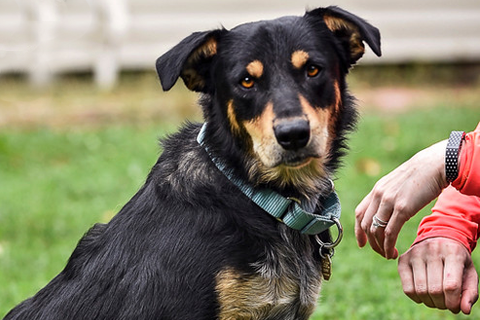As a dog trainer that specializes in behavioral issues I hear a variant of this phrase from someone new every day. “I don’t understand why my dog does this, I’ve done obedience training with him, and he’ll sit when I ask him to.” “This” can refer to biting, growling, pulling on leash, running away, fighting, and destroying the house…
I have noticed that when people get a dog they usually start to train him right away, but it is done for the wrong reasons. Most people train a dog simply because that’s what you do, you get a dog and then you teach him to sit. The problem that I see is that most training is now done in one of two ways. Most training involves treats or huge amounts of praise and excitement to shape the behavior. Using these methods is a great way to shape a certain action with your dog but I want you to analyze what you are creating. When we teach a dog to sit, down, come, or stay using these techniques they usually learn it very quickly, but what does that really help? The action that we just taught them is now an excitement tool; the dog performs his trick in order to get a reward and ends up more excited than when he started. This is a fine way to teach the dog to roll over, give paw, sit pretty, crawl or a thousand other tricks but it shouldn’t be used for obedience.
I use obedience for two main reasons. The first is to get a dogs respect and the second is as a calming tool. Think about it, when you tell your dog to down, do you want him wagging his tail and squirming in place barely able to control himself, or laying there contentedly waiting for you to calmly release him? Do you want to have to offer him a treat to listen, or do you want him to lie down at any point for any reason with any distraction around? When we teach a dog to listen to us because we are in charge, not through bribery, we automatically assume the leadership position. This simple change can help so much in our daily lives. Submissive dogs display fewer behavioral issues than dominant dogs and happier lives result.
This is very tough to do and is a skill acquired through years of practice and learning. I call the recent training phenomenon of humanizing dogs the “big box training method.” Large stores that hire thousands of trainers each year don’t have the luxury of finding experienced and skilled trainers (they also can’t afford them), so they hire trainers that practice the easiest method which is treat based training. Quick results ensue, but the dog never becomes obedient or calm, he just learns a bunch of fun tricks. There is nothing wrong with teaching your dog tricks in this manner, just don’t expect obedience to mean anything if you do it this way.
If you train your dog and get the obedience results you were looking for, but still have some behavioral issues, it is now time to call in a behaviorist. As a professional behaviorist I help owners deal with any issues that may come up, from resource guarding to unprovoked aggression towards humans or dogs. Just like doctors that specialize in different fields, all dog trainers are not equipped or trained to deal with every issue that can arise. Some trainers focus on agility while others focus on training hunting dogs. You wouldn’t go to your local podiatrist to get treatment for cancer, just as you shouldn’t go to your local agility instructor for help with behavioral issues. My biggest goal when working with dogs and humans is to teach people that obedience and behavior modification are two completely different things, but can be used together to get phenomenal results.




 WSHS can accept credit-card donations online using a secure server. Click on the Donate Now button. You can choose how your donation will be used! All donations are tax deductible.
WSHS can accept credit-card donations online using a secure server. Click on the Donate Now button. You can choose how your donation will be used! All donations are tax deductible.